
Whales are so similar to fish, especially to the shark family, that it's very easy to confuse their body traits when drawing. That's why we need to know them better to draw them properly. Follow me in a journey through the world of giant, intelligent, marine mammals—and learn to distinguish them from fish once and for all!
Whale Body Features
Skeleton
Let's look at a skeleton of a dolphin. It's going to be similar for all the whales. What can we say about it?
- The skull has elongated jaws and a distinctive braincase.
- The dorsal fin doesn't have any bones or rays inside (some dolphins don't develop this fin).
- The spine is similar to other mammals.
- The tail is horizontal.
- The pectoral fin (flipper) is actually a modified arm, with the same bones as in yours.
- The chest with ribs is present.
- There's a remnant of a pelvis, called vestigial pelvis.

Let's see how a dolphin (1) looks in comparison to a shark (2) and a typical fish (3). A good way to remember it is to imagine dolphins are mammals modified to look more like a fish. So you can see a skeleton of a human, a dog or a cat in your mind, and change it to be more fish-like in look.

What's also important, whales don't have gills. They need to breath air, and that's why they have a blowhole at the top of their heads, in the neck area.
Eyes
The eyes of whales are very simple and we don't need to draw them in detail. You can draw them as small dark ellipses with other ellipses as the ridges around.

Tail and Flippers
Both flukes (tail fins) and flippers (arm fins) can be drawn with the same method:
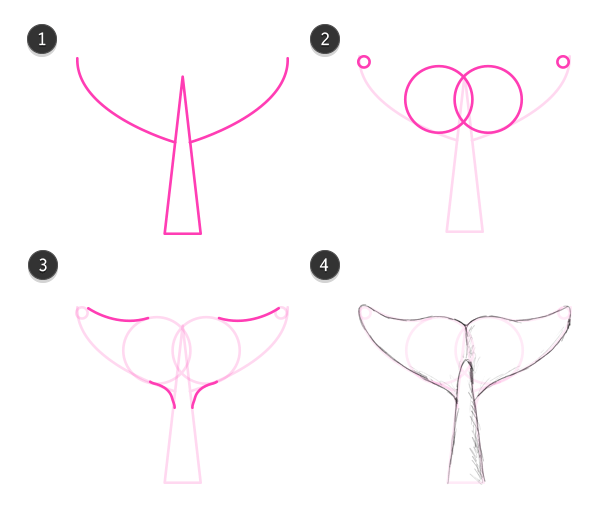
Movement
Let's see how whales move. Since their tail is horizontal, not vertical, they move in a different way than fish.
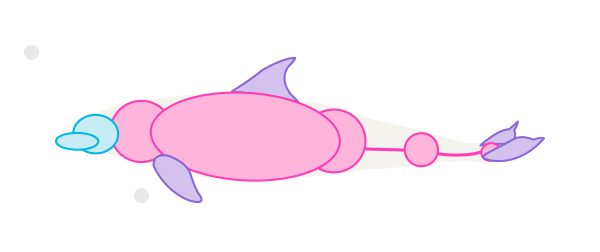
To remember this, keep in mind these two "arch" poses:

Compare the movement with a fish:

Meet the Whale Family
Let's learn about the actual species.
Bottlenose Dolphin
Smart and cute, bottlenose dolphins are known well as friends of humans. What do we know about how they look?
- The characteristic bottle nose is just a long, rounded snout. Notice the smile!
- The forehead is rounded.
- The dorsal fin is slightly curved.
- The body is gray, with a lighter bottom and a darker stripe along the back. Other species of dolphins may have more interesting patterns.
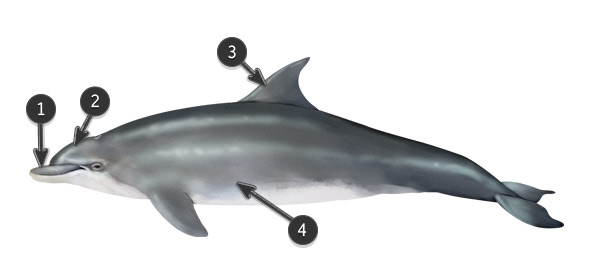

Porpoise
Porpoises are very similar to dolphins, but they aren't counted as ones. What's the difference between them?
- The snout is much shorter than with bottlenose dolphins, which makes them easy to distinguish.
- The dorsal fin is shorter and more rounded.
- There are characteristic, faint "stripes" between the eye and flippers.
- The colors are similar to a bottlenose dolphin.


Killer Whale (Orca)
These magnificent animals are very intelligent and they're able to create a whole culture that they pass to their young. Think about it next time you see them doing tricks in a small pool!
- The head is rounded, with each jaw having a different color.
- The dorsal fin is very large and long.
- The flippers are big and rounded.
- The body has a characteristic black and white pattern.



Beluga
- There's a distinctive round "melon" on the head. Notice the wrinkle under it.
- The dorsal fin is reduced to a ridge.
- There's a real neck behind the head—belugas don't have these bones fused as other whales do.
- The body is clean white.


Narwhal
They are called "unicorns of the sea", and that must be the reason they're often drawn incorrectly. What's so hard about drawing them?
- The long horn is actually a tooth, so don't place it in the middle of forehead.
- Notice the lack of the dorsal fin.
- Narwhals, just like belugas, do have a functional neck.
- The whole body is covered with speckles of gray and white.

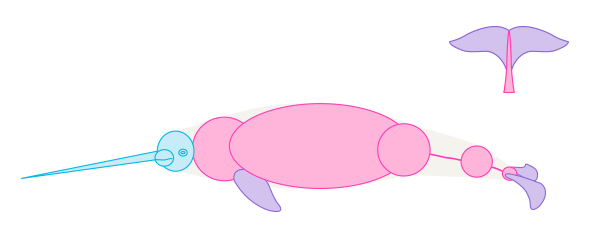
Since the horn is a tooth, and there's no "middle" tooth in any mammal species, there's no way for the horn to be in the center as with a unicorn. It's usually the left tooth, and some narwhals grow another one on the right, too!

Blue Whale
The blue whale is the biggest animal that has ever lived on Earth—bigger than any dinosaur! Luckily for us, they're peaceful krill-eaters.
- The head is long, with flattened jaws. There are two blowholes on a special ridge on the head.
- The dorsal fin is small and placed towards the back of the body.
- The stripes under the throat are called ventral pleats, and are able to expand when the animal is drinking.
- The body is much more elongated than those of other whales we've been talking about.


Final Exercise
Let's draw an example illustration of a mama killer whale and her baby.
Step 1
Start with a simple sketch. It should be just a doodle, nothing refined. Use your autopilot to draw it. If it's problematic for you, you may find this article helpful.

Step 2
Use the simplified scheme of a killer whale body to build the structure of the animals. Remember: if you feel it's too hard for you, it doesn't mean you can't draw a killer whale. Your problem lies in drawing simple forms in perspective, and that's what you should practice! You can also check this article.

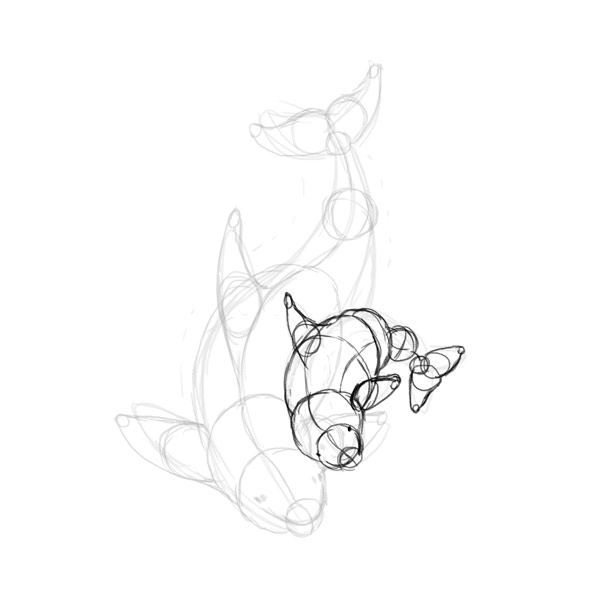
Step 3
Use the simple forms as guide lines for the general outline.

Step 4
Sketch the pattern.

Step 5
Use all the sketches to create a clean lineart.

Step 6
Finish the picture as you like.

That's All!
Today we've learned how to draw these smart mammals, and how not to confuse them with fish. If you enjoyed the lesson, take a look at other tutorials of mine—there's a whole animal world waiting to be discovered!







